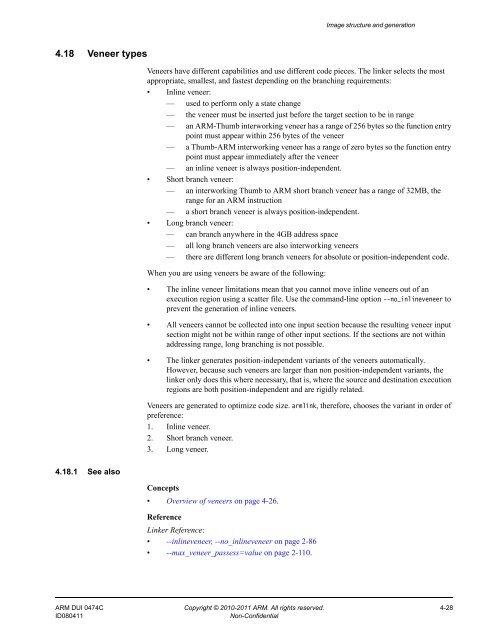ARM Compiler toolchain Using the Linker - ARM Information Center
ARM Compiler toolchain Using the Linker - ARM Information Center
ARM Compiler toolchain Using the Linker - ARM Information Center
Create successful ePaper yourself
Turn your PDF publications into a flip-book with our unique Google optimized e-Paper software.
4.18 Veneer types<br />
4.18.1 See also<br />
Image structure and generation<br />
Veneers have different capabilities and use different code pieces. The linker selects <strong>the</strong> most<br />
appropriate, smallest, and fastest depending on <strong>the</strong> branching requirements:<br />
• Inline veneer:<br />
— used to perform only a state change<br />
— <strong>the</strong> veneer must be inserted just before <strong>the</strong> target section to be in range<br />
— an <strong>ARM</strong>-Thumb interworking veneer has a range of 256 bytes so <strong>the</strong> function entry<br />
point must appear within 256 bytes of <strong>the</strong> veneer<br />
— a Thumb-<strong>ARM</strong> interworking veneer has a range of zero bytes so <strong>the</strong> function entry<br />
point must appear immediately after <strong>the</strong> veneer<br />
— an inline veneer is always position-independent.<br />
• Short branch veneer:<br />
— an interworking Thumb to <strong>ARM</strong> short branch veneer has a range of 32MB, <strong>the</strong><br />
range for an <strong>ARM</strong> instruction<br />
— a short branch veneer is always position-independent.<br />
• Long branch veneer:<br />
— can branch anywhere in <strong>the</strong> 4GB address space<br />
— all long branch veneers are also interworking veneers<br />
— <strong>the</strong>re are different long branch veneers for absolute or position-independent code.<br />
When you are using veneers be aware of <strong>the</strong> following:<br />
• The inline veneer limitations mean that you cannot move inline veneers out of an<br />
execution region using a scatter file. Use <strong>the</strong> command-line option --no_inlineveneer to<br />
prevent <strong>the</strong> generation of inline veneers.<br />
• All veneers cannot be collected into one input section because <strong>the</strong> resulting veneer input<br />
section might not be within range of o<strong>the</strong>r input sections. If <strong>the</strong> sections are not within<br />
addressing range, long branching is not possible.<br />
• The linker generates position-independent variants of <strong>the</strong> veneers automatically.<br />
However, because such veneers are larger than non position-independent variants, <strong>the</strong><br />
linker only does this where necessary, that is, where <strong>the</strong> source and destination execution<br />
regions are both position-independent and are rigidly related.<br />
Veneers are generated to optimize code size. armlink, <strong>the</strong>refore, chooses <strong>the</strong> variant in order of<br />
preference:<br />
1. Inline veneer.<br />
2. Short branch veneer.<br />
3. Long veneer.<br />
Concepts<br />
• Overview of veneers on page 4-26.<br />
Reference<br />
<strong>Linker</strong> Reference:<br />
• --inlineveneer, --no_inlineveneer on page 2-86<br />
• --max_veneer_passess=value on page 2-110.<br />
<strong>ARM</strong> DUI 0474C Copyright © 2010-2011 <strong>ARM</strong>. All rights reserved. 4-28<br />
ID080411 Non-Confidential

















